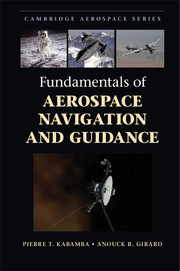Book contents
- Frontmatter
- Dedication
- Contents
- Preface
- 1 Introduction
- 2 Deterministic Systems Theory
- 3 Stochastic Systems Theory
- 4 Navigation
- 5 Homing Guidance
- 6 Ballistic Guidance
- 7 Midcourse Guidance
- 8 Optimization
- 9 Optimal Guidance
- 10 Introduction to Differential Games
- Epilogue
- APPENDIX A Useful Definitions and Mathematical Results
- Bibliography
- Index
3 - Stochastic Systems Theory
Published online by Cambridge University Press: 05 October 2014
- Frontmatter
- Dedication
- Contents
- Preface
- 1 Introduction
- 2 Deterministic Systems Theory
- 3 Stochastic Systems Theory
- 4 Navigation
- 5 Homing Guidance
- 6 Ballistic Guidance
- 7 Midcourse Guidance
- 8 Optimization
- 9 Optimal Guidance
- 10 Introduction to Differential Games
- Epilogue
- APPENDIX A Useful Definitions and Mathematical Results
- Bibliography
- Index
Summary
This chapter presents the elements of stochastic systems theory that we use in the analysis and synthesis of navigation and guidance systems. Roughly speaking, a stochastic phenomenon is randomly unpredictable but exhibits “statistical regularity,” in a sense defined subsequently. Consistent with our emphasis on linear systems, justified in Chapter 2, the purpose of this chapter is to quantify how linear systems respond to uncertain input signals.
We use stochastic models to account for uncertainty for at least two compelling reasons. The first one is purely pragmatic: stochastic models have proven extremely effective in modeling uncertainty in science and engineering and provide a rational basis for taking and optimizing decisions in the presence of the unknown. The second, deeper reason, appeals to the fundamental postulate of natural science [24], which states that “nature is governed by laws that are uniform.” Although this postulate leads us to expect that natural phenomena be highly and exactly repeatable, the uncertainty we observe in practice seems to violate this expectation. A way to resolve this dilemma is to relax the notion of exact repeatability into that of statistical regularity, leading seamlessly to stochastic systems theory. Hence stochastic systems theory affords a provision for uncertainty within the context of the fundamental postulate of natural science.
The motivation of this chapter is that many phenomena in navigation and guidance can be modeled as stochastic. They include measurement errors in components of acceleration, velocity and position, drift of gyroscopes, wind gusts, and so on, and the navigation and guidance errors that the aforementioned generate.
- Type
- Chapter
- Information
- Fundamentals of Aerospace Navigation and Guidance , pp. 48 - 77Publisher: Cambridge University PressPrint publication year: 2014

